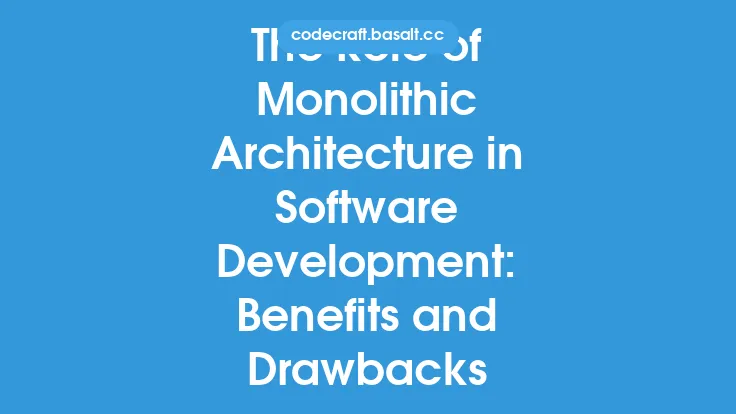When it comes to designing software, one of the most critical decisions is choosing the right architecture. Two popular approaches are monolithic and modular architectures. In this article, we will delve into the differences between these two architectures, their advantages and disadvantages, and provide guidance on how to choose the right one for your software project.
Introduction to Monolithic Architecture
Monolithic architecture is a traditional approach to software design where the entire application is built as a single, self-contained unit. This means that all components, including the user interface, business logic, and data storage, are tightly coupled and reside in the same codebase. Monolithic architectures are often characterized by a single, monolithic codebase, a single database, and a single deployment unit. This approach has been widely used in the past, especially for small to medium-sized applications, due to its simplicity and ease of development.
Introduction to Modular Architecture
Modular architecture, on the other hand, is a more modern approach to software design that emphasizes separation of concerns and loose coupling between components. In a modular architecture, the application is broken down into smaller, independent modules, each with its own specific responsibility. These modules can be developed, tested, and deployed independently, allowing for greater flexibility and scalability. Modular architectures are often characterized by multiple, separate codebases, multiple databases, and multiple deployment units.
Key Differences Between Monolithic and Modular Architectures
The key differences between monolithic and modular architectures lie in their design principles, advantages, and disadvantages. Monolithic architectures are simple, easy to develop, and test, but they can become cumbersome and difficult to maintain as the application grows. Modular architectures, on the other hand, are more complex, but they offer greater flexibility, scalability, and maintainability. The following are some of the key differences between monolithic and modular architectures:
- Tight Coupling vs Loose Coupling: Monolithic architectures are characterized by tight coupling between components, whereas modular architectures emphasize loose coupling.
- Separation of Concerns: Modular architectures separate concerns into independent modules, whereas monolithic architectures combine all concerns into a single codebase.
- Scalability: Modular architectures are more scalable than monolithic architectures, as individual modules can be scaled independently.
- Maintainability: Modular architectures are easier to maintain than monolithic architectures, as individual modules can be updated or replaced without affecting the entire application.
Choosing the Right Architecture for Your Software
Choosing the right architecture for your software depends on several factors, including the size and complexity of the application, the development team's experience and expertise, and the project's requirements and constraints. The following are some guidelines to help you choose between monolithic and modular architectures:
- Small to Medium-Sized Applications: Monolithic architectures may be suitable for small to medium-sized applications with simple requirements and a small development team.
- Large and Complex Applications: Modular architectures are more suitable for large and complex applications with multiple requirements and a large development team.
- Rapid Development and Deployment: Monolithic architectures may be suitable for applications that require rapid development and deployment, such as prototypes or proof-of-concepts.
- Scalability and Maintainability: Modular architectures are more suitable for applications that require scalability and maintainability, such as enterprise-level applications or applications with high traffic.
Technical Considerations
When choosing between monolithic and modular architectures, there are several technical considerations to keep in mind. The following are some of the key technical considerations:
- Programming Languages and Frameworks: The choice of programming language and framework can influence the choice of architecture. For example, some frameworks, such as Ruby on Rails, are more suited to monolithic architectures, while others, such as Java Spring, are more suited to modular architectures.
- Database Design: The design of the database can also influence the choice of architecture. For example, a monolithic architecture may require a single, centralized database, while a modular architecture may require multiple, distributed databases.
- API Design: The design of the API can also influence the choice of architecture. For example, a monolithic architecture may require a single, monolithic API, while a modular architecture may require multiple, separate APIs.
Best Practices for Implementing Monolithic and Modular Architectures
Regardless of the chosen architecture, there are several best practices to keep in mind when implementing monolithic and modular architectures. The following are some of the key best practices:
- Separation of Concerns: Separate concerns into independent modules or components to improve maintainability and scalability.
- Loose Coupling: Use loose coupling between components to improve flexibility and scalability.
- API-First Design: Use API-first design to improve the design of the API and ensure that it is modular and scalable.
- Continuous Integration and Deployment: Use continuous integration and deployment to improve the speed and quality of development and deployment.
Conclusion
In conclusion, choosing the right architecture for your software depends on several factors, including the size and complexity of the application, the development team's experience and expertise, and the project's requirements and constraints. Monolithic architectures are simple, easy to develop, and test, but they can become cumbersome and difficult to maintain as the application grows. Modular architectures, on the other hand, are more complex, but they offer greater flexibility, scalability, and maintainability. By considering the key differences between monolithic and modular architectures, choosing the right architecture for your software, and following best practices for implementation, you can ensure that your software is scalable, maintainable, and meets the requirements of your users.





